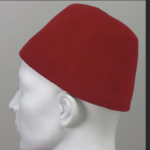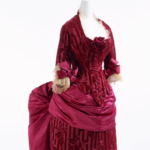1300-1349
OVERVIEW Womenswear Wikipedia writes of fourteenth-century clothing: “Wool was the most important material for clothing, due to its numerous favorable qualities,...
OVERVIEW Womenswear Wikipedia writes of fourteenth-century clothing: “Wool was the most important material for clothing, due to its numerous favorable qualities,...
1350-1399 Womenswear Wikipedia writes of fashion in this period: “The innermost layer of a woman’s clothing was a linen or woolen chemise or smock, some...
In the first years of the war-torn fifteenth century, fashion was a battleground where rulers and courtiers lay claim to power with the display of luxury textiles, elaborate dagging and fanciful personal emblems. Throughout the decade, the fashions launched at the court of France influenced the rest of Europe. In England, Germany and Italy, sumptuary laws intent on preserving distinctions between nobles and commoners signal the wealth of the middle class and their increased ability to participate in fashion.
Fashion during this decade turned away from extravagance and towards simplicity. The elaborate fashions of the court of France that were dominant throughout Europe reached their peak in 1415. In that year, the French defeat at the hands of the English at the Battle of Agincourt, in part because they were over-armored and over-dressed, forced a reckoning. Long houppelandes, bombard sleeves, and decorative dagging declined, and the English and Burgundians took a greater share in fashion leadership.
The duchy of Burgundy, enriched by the wealth of its Flemish cities, was the leading center of fashion during the 1420s. The Duke of Burgundy’s alliance with England supported the production of the finest woolen textiles, woven in Flanders from English yarn. Merchants used their profits from manufacture and trade to rival aristocrats as the greatest consumers of Italian silk velvets and other luxuries. Throughout Europe, men dressed in black and women with tall, horn-shaped headdresses were signs of Burgundian influence.
The court of Burgundy, where courtiers vied for status in countless variations of houppelandes, huques and chaperons continued to dominate fashion in Europe during this decade. Meanwhile in Italy, where we find some of the earliest surviving fashion designs, distinctive styles inspired by classical antiquity signaled a new direction.
The 1440s was a period centered around a more angular silhouette in fashion along with the end of popular fashions from the previous decade including the houppelande and other accessories. Regional fashions continued and fashion hubs were influenced by political events including the Hundred Years War.
Following the significant changes of the previous decade, the 1450s was a period of relative stability in fashion. The new proportions and trends of the 1440s developed further and were refined. Men’s outer garments grew shorter, and women’s headdresses grew higher, until they became the tall pointed cones with hanging veils that have captured the imagination ever since.
During the 1460s the differences between the fashions of Italy and those of northern Europe deepened. At the courts of Burgundy and France, men and women’s silhouettes were elongated and angular, from the tops of women’s conical headdresses to the points of men’s poulaine shoes. In Italy, inspired by the art and dress of antiquity, more naturalistic proportions and flowing drapery prevailed.
1470s fashion emphasized the undergarment, creating a tighter silhouette that revealed the chemise underneath. At the same time, Spain had a great influence on other regions lead by fashion icon Charles the Bold who impacted both menswear and womenswear in his era.
In the 1480s the fashions of Florence shine, immortalized in the work of Ghirlandaio and Botticelli, who create an enduring ideal of beauty and demonstrate the connection between contemporary fashion and the dress of the ancient Greeks and Romans. At the same time, Spanish influence continued to spread, introducing a new hairstyle and new outer garments. In northern Europe, we see the last of the angular silhouette as a new one emerges, slender and streamlined for men and molded for women, hinting at the beginnings of corsetry. This decade is the beginning of the transition to sixteenth-century fashion.
The 1490s was an influential decade that set the groundwork for the following years to come in terms of predominant trends and silhouette. At the same time, regional influence held strong both in Italy and Spain.

 fez
fez 1883 – Charles Frederick Worth, red silk satin and velvet dinner dress
1883 – Charles Frederick Worth, red silk satin and velvet dinner dress The Fez and the Ottoman Path to Modernity
The Fez and the Ottoman Path to Modernity 1869 – Red Silk Dress
1869 – Red Silk Dress